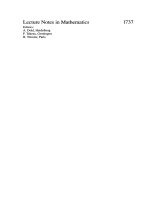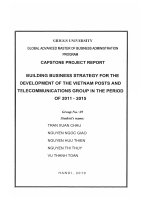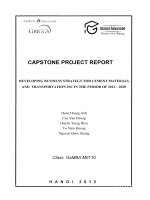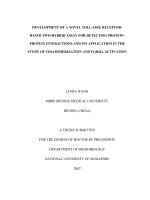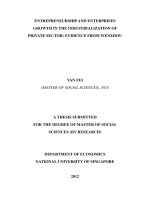Genetic divergence and cluster analysis in coriander germplasm (Coriandrum sativum L.) in high hills of Garhwal Himalayas
Bạn đang xem bản rút gọn của tài liệu. Xem và tải ngay bản đầy đủ của tài liệu tại đây (233.43 KB, 6 trang )
Int.J.Curr.Microbiol.App.Sci (2019) 8(4): 1122-1127
International Journal of Current Microbiology and Applied Sciences
ISSN: 2319-7706 Volume 8 Number 04 (2019)
Journal homepage:
Original Research Article
/>
Genetic Divergence and Cluster Analysis in Coriander Germplasm
(Coriandrum sativum L.) in High Hills of Garhwal Himalayas
Jaidev Chauhan1*, Suyanka Raturi2, Ajaya Paliwal2 and Pankaj Bahuguna3
1
Department of Herbal Biotechnology Division, High Altitude Plant Physiology Research
Centre (HAPPRC), H.N.B.G.U. (A Central University), Srinagar Garhwal,
Uttarakhand 246174, India
2
Department of Genetics and Plant Breeding, 3Department of Statistics and Computer
Application, University of Horticulture and Forestry, Bharsar, Pauri Garhwal, Uttarakhand
246123, India
*Corresponding author:
ABSTRACT
Keywords
Coriander, Genetic
diversity and
Genetic divergence
Article Info
Accepted:
10 March 2019
Available Online:
10 April 2019
Twenty four genotypes of coriander were evaluated in Kharif season for different
horticultural traits viz., days to 50% flowering, days to first umbel unfolding, Maturity
duration, plant height, primary branches per plant, secondary branches per plant, test
weight, fruits per umbel, fruits per umbellate, seed yield per plot and seed yield per plant
etc. Cluster analysis based on Ward’s minimum variance procedure distributed the into 5
clusters indicating their broad genetic base of which Maximum numbers of genotypes
were accommodated in the cluster-IV (9) followed by cluster-I (4) cluster-II (4) and
cluster-V (4). The intra cluster distance was found maximum in cluster III and minimum in
cluster II. Whereas, highest inter cluster distance was recorded between cluster III and IV
and lowest was observed between cluster IV and V. While there genetic diversities were
classified on the basis of D2 analysis these genotypes were grouped into five divergent
clusters and hybridization between cluster III and IV is expected to give maximum
heterotic cross combinations in future breeding programs.
Introduction
Coriander (Coriandrum sativum L.) belongs
to family Apiaceae originated from the
Mediterranean region. Coriander is a popular
seed spice which is grown from temperate to
tropical regions of the world. It is one of the
important seed spice. Coriander is useful as
spice, in a form of curry powder, as in
confectionary and in flavouring gin.
Economic returns to seed spice growers are
high due to more yields per unit area in short
growing period. Genetic variability plays an
important role in a crop in selecting the best
genotypes for making rapid improvement in
yield and other desirable characters as well as
1122
Int.J.Curr.Microbiol.App.Sci (2019) 8(4): 1122-1127
to select the potential parent of hybridization
programs.
Materials and Methods
The investigation was carried out at the
Medicinal and Aromatic Block, Department
of Spices, Plantation, Medicinal and Aromatic
Plants, College of Horticulture, Bharsar,
VCSG Uttarakhand University of Horticulture
and Forestry Bharsar. Seeds were sown
directly in the field during the month of
February 16, 2016 at a spacing of (30×15) cm
in a plot of (1.5×1.2) m2 size. There were five
rows in each plot. Forty plants of each
genotype were planted in each replication.
Each genotype was sown in a Random
Complete Block Design (RCBD) with three
replications. The standard cultural practices
recommended in the Package of Practices for
Seed Spices Crops, were followed to ensure a
healthy crop stand. The obtained data was
analyzed for genetic divergence.
Results and Discussion
Genetic divergence studies
In the present studies, the genetic divergence
observed among twenty four diverse
genotypes of Coriander showed good
quantum of divergence (Fig. 1). All the
genotypes were grouped into 5 clusters using
the Ward’s minimum variance procedure
(Anderberg, 1993) and the distributions of the
genotypes into different clusters are depicted
in Table 1 and Figure 2. Maximum numbers
of genotypes were accommodated in the
cluster-IV (9) followed by cluster-I (4)
cluster-II (4) and cluster-V (4). The average
intra and inter-cluster Euclidean2 distance
were estimated based on Ward’s minimum
variance and are presented in the Table 2. The
intra cluster distance was found maximum in
cluster III and minimum in cluster II.
Whereas, highest inter cluster distance was
recorded between cluster III and IV and
lowest was observed between cluster IV and
V. The nearest and farthest cluster for each of
the five clusters is presented in Table 3.
Cluster means were computed for the 13
characters studied by Ward’s minimum
variance method and are presented in Table 4.
Out of all clusters, cluster III showed higher
mean values for most of the yield contributing
traits like plant height, umbel diameter, days
to 50% flowering, umbel per plant indicating
the importance of cluster genotypes in
coriander yield improvement programmes.
Crossing between the genotypes of two
clusters appeared to be most promising to
combine the desirable characters. In the
present investigations, cluster IV was found
more divergent and there will be more
chances of getting better segregants in F2 and
subsequent generations from the crossing
genotypes from cluster III and IV. Earlier
workers like Singh et al., (2005), Ravi et al.,
(2009), Beemet et al., (2011) and Srivastava
et al., (2000). From the present investigation,
it can be concluded that Nine genotypes viz.,
cluster IV that includes 9 coriander varieties,
namely R-CO-75, Siku-LC, Bareilly Local,
RL-13, RS, ALC, LS-800, Small CO and CO4. Lowest numbers of genotypes were present
in Cluster III, that include only three
coriander genotypes; Pant Haritma, KPL and
PD-21. For the traits, where selection is not
effective, genetic divergence can play an
important role on further partitioning of
variability. In the present investigation, the
cluster III and cluster IV were found more
divergent and there will be more chances of
getting better segregants in F2 generations
from the crossing of genotypes from cluster
III and cluster IV. While cluster means, the
cluster mean in case of days to 50% flowering
was highest in cluster V and lowest in cluster
III. While for days to first umbel unfolding
was highest in cluster II and lowest in cluster
I, for number of days to maturity duration was
highest in cluster III and lowest in case of
cluster IV.
1123
Int.J.Curr.Microbiol.App.Sci (2019) 8(4): 1122-1127
Table.1 Clustering pattern of twenty four genotypes of coriander on the basis of genetic
divergence
Clusters
I
II
III
IV
Number of genotypes
4
4
3
9
V
4
Genotypes along with their sources
Pant LC, PLI-100, PLC and Dhulet Local
HL-Thick, HL-Normal, , HL-Big and TLC
Pant Haritma, PD-21 and KPL
R-CO-75, Bareilly Local, RL-13, RS, ALC, Siku-LC, Small CO, LS-800
and CO-4
Kota, Hanumangarh Rajasthan, Jaunpur Local and Lakhimpur
Table.2 Average intra and inter cluster distance (D2)
Clusters
I
II
III
IV
V
I
139.54
308.24
556.77
862.26
692.21
II
III
IV
V
31.78
1324.49
248.61
216.09
159.22
2271.66
1774.36
99.6
166.37
33.88
Note: Diagonal values bold and underlined are intra-cluster distances. Off-diagonal values are inter-cluster distances
Table.3 The nearest and the farthest cluster from each cluster using Ward’s Minimum Variance
method in twenty four genotypes of coriander (Coriandrum sativum L.)
Clusters No.
I
II
III
IV
V
Nearest cluster with D2 values
II (308.24)
I (139.54)
I (556.77)
II (248.61)
IV (166.37)
Farthest cluster with D2 values
IV (862.26)
III (1324.49)
IV (2271.66)
V (166.37)
III (1774.36)
Table.4 Cluster means for different trait in twenty four genotypes of coriander
Sr. No.
1
2
3
4
5
6
7
8
9
10
11
12
13
14
Traits
Days to 50 % flowering
Days to first umbel unfolding
Maturity duration
Plant height (cm)
Primary branches
Secondary branches
Umbel per plant
Umbellates per umbel
Umbel diameter (mm)
Fruits per umbel
Fruits per umbellate
Test weight (gm)
Seed yield per plant (gm)
Seed yield per plot (gm)
I
43.82
33.45
104.26
55.79
2.02
4.34
12.56
4.11
21.59
19.01
4.05
15.79
4.08
151.85
II
47.72
39.69
102.75
48.61
2.12
4.36
11.20
3.61
24.49
13.91
4.28
10.65
1.67
63.13
Cluster No.
III
IV
42.57
45.47
34.48
36.80
111.95
88.02
64.98
34.15
3.13
2.27
5.88
4.59
15.55
6.43
4.88
3.65
32.40
27.05
22.57
13.75
4.44
3.49
20.56
3.08
7.36
0.31
281.33
11.55
Note: Bold figures indicate minimum and maximum values in each character
1124
V
48.96
39.48
90.91
40.86
3.45
7.52
7.95
3.83
29.61
18.20
4.21
4.87
0.71
27.21
Int.J.Curr.Microbiol.App.Sci (2019) 8(4): 1122-1127
Fig.1 Dendrogram showing relationship of 24 genotypes in five clusters based on Euclideans2
Distance
1125
Int.J.Curr.Microbiol.App.Sci (2019) 8(4): 1122-1127
Fig.2 Intra and inter-cluster distance of 24 coriander (Coriandrum sativum L.) genotypes in five
clusters based on Euclidean2 values
While cluster mean value for the plant height
was found in cluster III and lowest in the
cluster IV. The cluster means for number of
primary branches per plant was highest in the
cluster V and lowest in cluster I, while cluster
mean for number of umbel per plant was
highest in cluster III and lowest in cluster IV.
For umbel diameter cluster mean was highest
in case of cluster III and lowest in cluster I.
The cluster mean for number of fruits per
umbel was highest in cluster III and lowest in
cluster IV. While cluster mean value for test
weight was highest in the cluster III and
lowest in cluster IV. For seed yield per plant
cluster III has the highest values that means
genotypes of this cluster must invariability be
used for the improvement of yield while
designing crossing plans as per their
performance usually transferred to advance
breeding generations if they are coming from
additive gene effect. Therefore, hybridization
between the genotypes of these groups can be
1126
Int.J.Curr.Microbiol.App.Sci (2019) 8(4): 1122-1127
effective for
Coriander.
further
improvement
in
References
Anderberg, M.R. 1993. Cluster Analysis for
Application. Academic Press, New
York
Beemnet M, Getinet A and Bizuayehu T.
2011. Genetic divergence in Ethiopian
coriander accessions and its implication
in breeding of desired plant type.
African Crop Science Journal 19(1):
39-47.
Ravi R, Prakash M and Bhatt K. 2009. Aroma
characterization
of
coriander
(Coriandrum sativum L.) European
Food Research and Technology 225(34):367-374.
Singh S P, Katiyar R S, Rai S K, Tripathi S M
and Srivastava J P. 2005. Genetic
divergence and its implication in
breeding of desired plant type in
coriander (Coriandrum sativum L.).
Journal of genetics 37(2):155-163.
Srivastava J P, Srivastava K and Tripathi S
M. 2000. Path analysis in coriander
(Coriandrum sativum L.). Spices and
aromatic plants: challenges and
opportunities in the new century
Contributory
papers
Centennial
conference on spices and aromatic
plants, Calicut, Kerala, India, 20-23-23September. 2000 68-70.
How to cite this article:
Jaidev Chauhan, Suyanka Raturi, Ajaya Paliwal and Pankaj Bahuguna. 2019. Genetic
Divergence and Cluster Analysis in Coriander Germplasm (Coriandrum sativum L.) in High
Hills of Garhwal Himalayas. Int.J.Curr.Microbiol.App.Sci. 8(04): 1122-1127.
doi: />
1127

